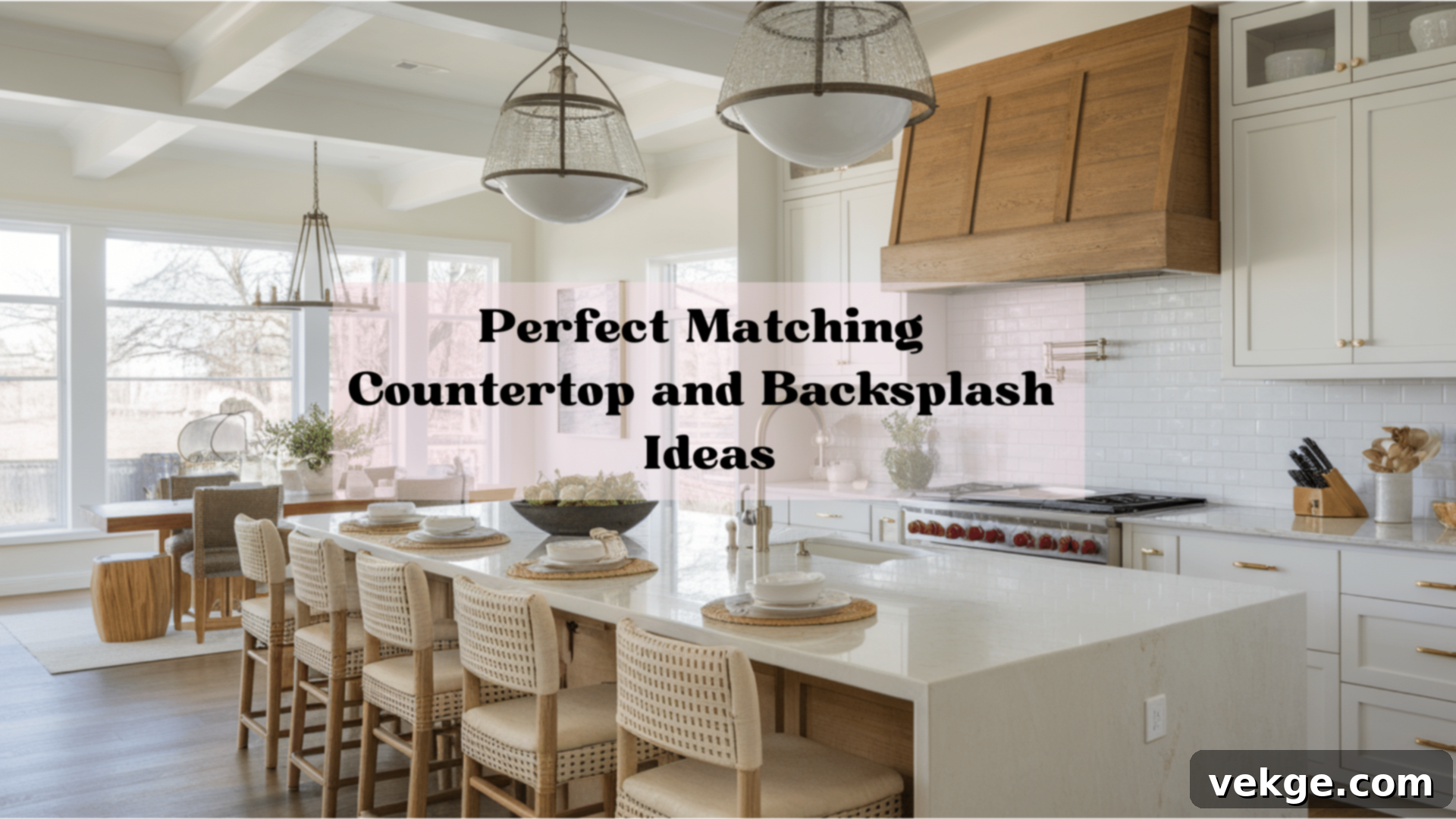The Ultimate Guide to Seamless Kitchen Design: Perfect Countertop and Backsplash Pairings
Creating a truly cohesive and inviting kitchen hinges significantly on the harmony between your countertops and backsplash. These two prominent surfaces act as the visual anchors of your culinary space, setting the tone for its overall aesthetic. When chosen thoughtfully, they can elevate your kitchen from merely functional to a beautifully integrated sanctuary. Conversely, mismatched elements can leave the space feeling disjointed or unfinished, detracting from its potential.
Many homeowners often grapple with the decision: should these surfaces match identically for a streamlined look, or should they offer a pleasing contrast to add depth and character? The answer often lies in a delicate balance of personal taste, budget constraints, and the practical demands of your daily kitchen use.
The market offers a dazzling array of materials for both components. Popular countertop choices like durable quartz, elegant granite, and luxurious marble each bring distinct textures, patterns, and levels of resilience. For backsplashes, options abound, from classic ceramic and porcelain tiles to sophisticated natural stone, sleek glass, and even a seamless extension of your chosen countertop material. Navigating these choices to find the perfect synergy is key to crafting a kitchen that not only looks spectacular but also feels right for you.
In this comprehensive guide, we’ll explore winning combinations that promise to inspire and inform your design decisions, ensuring your kitchen becomes a masterpiece of coordinated style and functionality.
Inspiring Countertop and Backsplash Combinations for Your Kitchen
1. Quartz Countertop with Matching Quartz Backsplash

Opting for the same quartz material for both your countertop and backsplash is a design choice that speaks volumes of modern elegance and practicality. This continuous application creates a sleek, uninterrupted surface that makes kitchens, especially smaller ones, feel more expansive and uncluttered. The absence of grout lines, particularly behind the cooking area, makes cleaning incredibly simple and efficient, enhancing the hygienic appeal of your kitchen. This minimalist yet sophisticated pairing is a favorite among those who appreciate clean lines and seamless transitions, often found in contemporary and transitional kitchen designs.
2. Granite Countertop with Classic White Subway Tile Backsplash
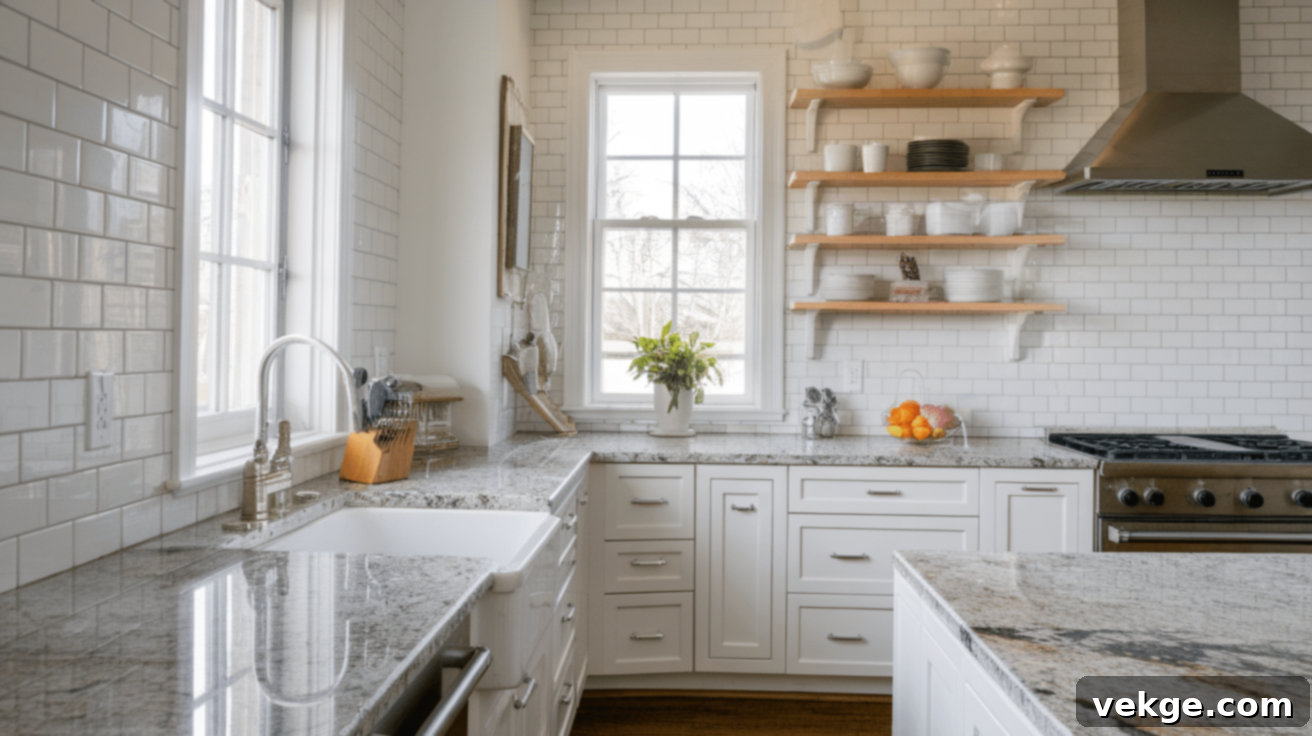
This timeless combination marries the unique, natural beauty of granite countertops with the understated simplicity of white subway tiles. The neutral, clean backdrop provided by the subway tiles allows the intricate patterns and rich colors of your granite to truly shine as the focal point. This pairing is particularly effective with granites that feature complex veining or flecks of white, creating a harmonious link between the two surfaces without overwhelming the eye. It’s a versatile choice that adapts beautifully to a wide range of kitchen styles, from classic to farmhouse and even modern, always exuding a sense of refined taste.
3. White Marble Countertop with White Marble Backsplash
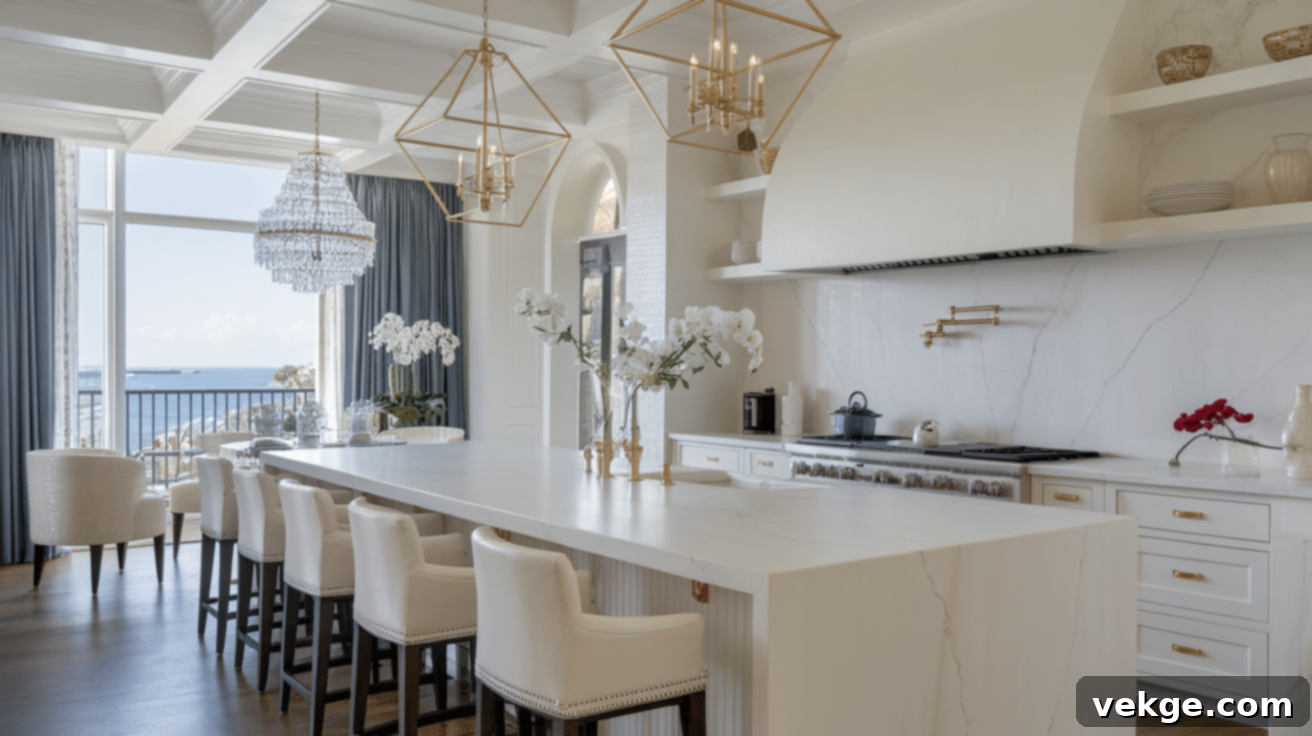
For an unparalleled statement of luxury and sophistication, matching white marble on both your countertops and backsplash creates an ethereal, high-end aesthetic. The continuous flow of marble’s dramatic veining gives a sense of boundless elegance, making the kitchen feel significantly more open and grand. While this choice represents a more substantial investment, the natural beauty and unique character of marble deliver a one-of-a-kind space that is both classically inspired and strikingly contemporary. It’s a bold yet beautiful commitment to timeless design.
4. Black Granite Countertop with Black Subway Tile
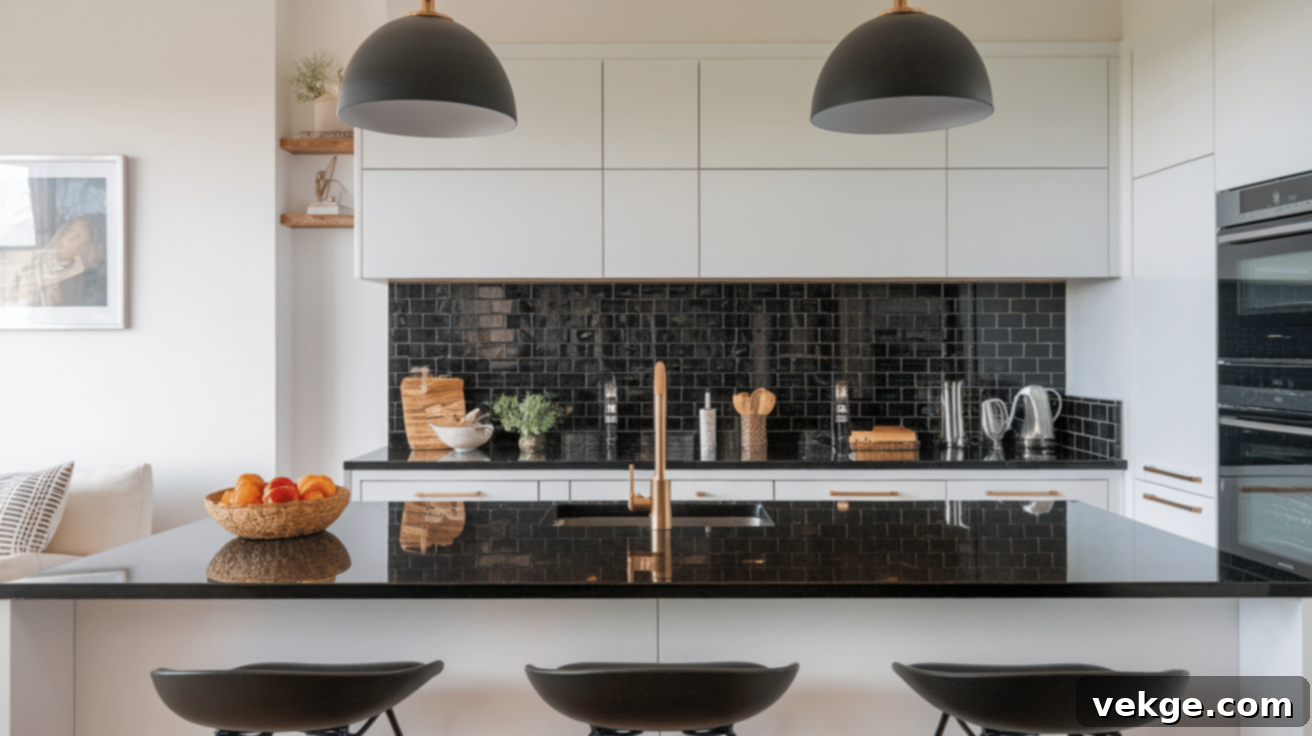
This powerful combination makes a strong, sophisticated statement, injecting a touch of drama and depth into any kitchen. The varied textures between the often-polished black granite and the slightly reflective black subway tiles create visual interest, even within a monochromatic scheme. This pairing is particularly impactful when contrasted with white or light-colored cabinets, where the dark surfaces create a striking visual anchor, offering a contemporary and luxurious feel. It’s an excellent choice for homeowners seeking a bold, modern kitchen design with an edgy twist.
5. Carrara Marble Countertop with White Subway Tile

Achieve an effortlessly bright and airy kitchen ambiance by pairing the subtle elegance of Carrara marble countertops with crisp white subway tiles. The delicate gray veining characteristic of Carrara marble harmonizes beautifully with the clean lines of the white subway tile, creating a serene and sophisticated look. This combination also offers a smart budgetary approach: you can indulge in the luxurious appeal of marble for your countertops while leveraging the cost-effectiveness of subway tiles for the backsplash, achieving a high-end look without breaking the bank. It’s a testament to classic style meeting practical design.
6. Wooden Countertop with White Subway Tile Backsplash
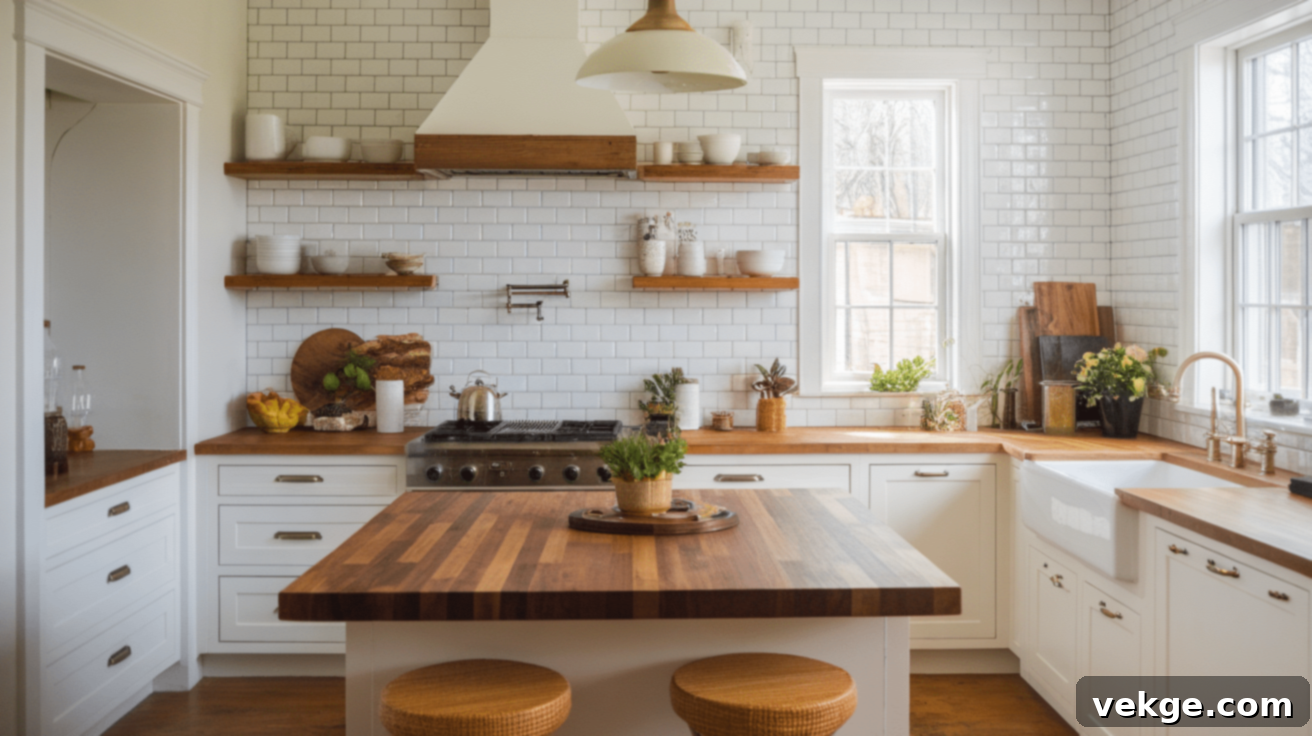
For a kitchen that radiates warmth and inviting charm, consider the organic appeal of butcher block or other wooden countertops combined with a clean white subway tile backsplash. The rich, natural tones of wood introduce an undeniable coziness, while the white backsplash ensures the space feels bright, open, and fresh. This versatile pairing is perfectly suited for a variety of styles, from rustic farmhouse and charming cottage to even modern homes looking to infuse natural elements. It strikes a beautiful balance between traditional warmth and contemporary lightness.
7. Granite Countertop with Complementary Gray Backsplash
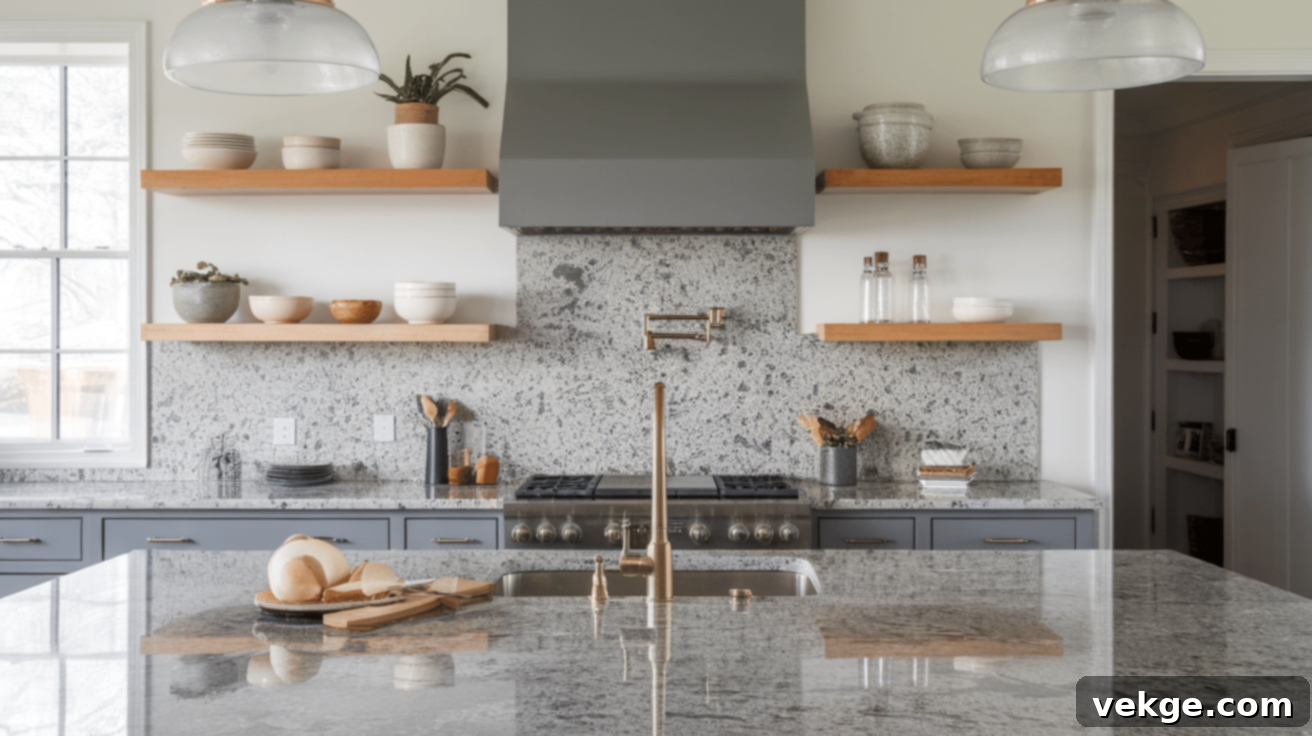
When your granite countertop features a myriad of flecks and patterns, a gray backsplash chosen to pick up one of these subtle tones can create a sophisticated visual flow. A subdued gray backsplash offers a calming balance to the inherent busyness of many granite patterns, preventing the space from feeling overwhelmed. This thoughtful pairing is particularly effective in kitchens with either white or dark cabinetry, bringing all elements together for a polished and cohesive appearance. It’s an excellent strategy for achieving harmony in a kitchen with a detailed countertop.
8. Marble Countertop with Black and White Herringbone Backsplash
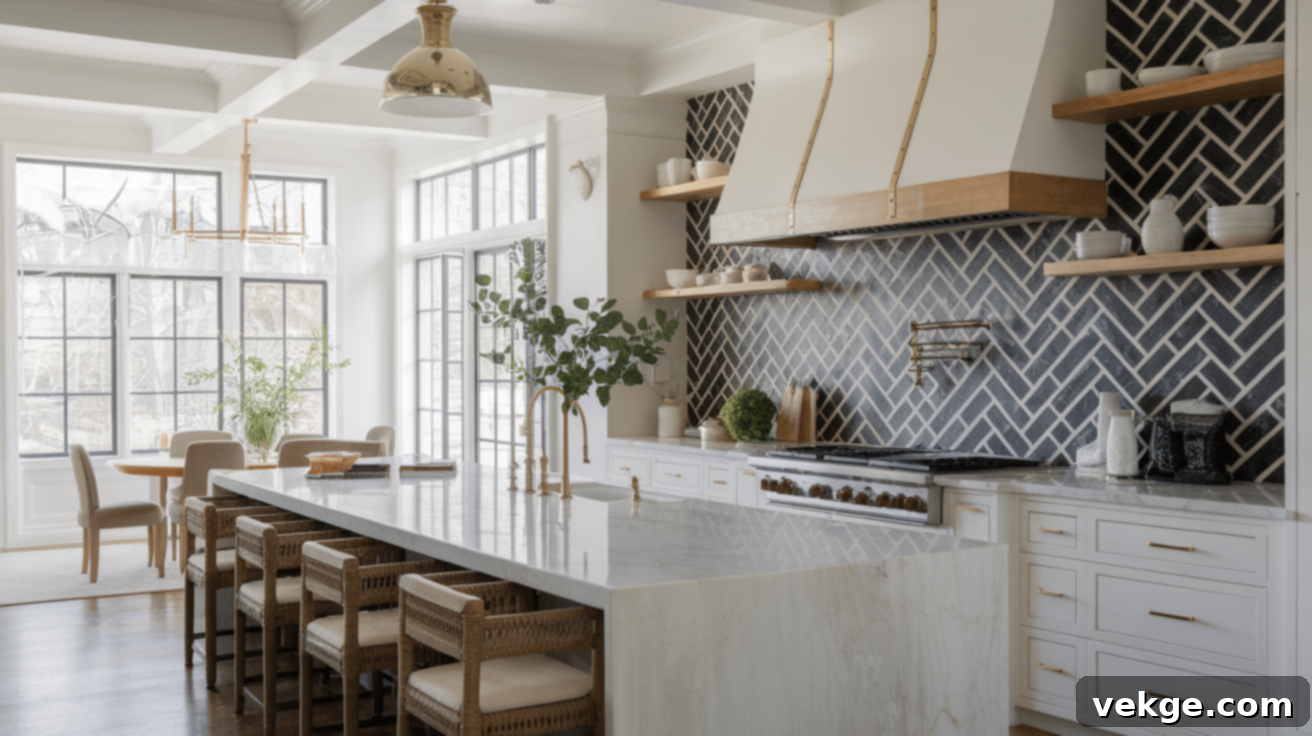
Infuse your marble countertops with an extra layer of visual intrigue by pairing them with a striking black and white herringbone tile backsplash. The classic, dynamic pattern of the herringbone adds a captivating sense of movement and architectural interest, all while beautifully complementing the natural elegance of the marble. This combination exudes a timeless yet refreshingly modern vibe, making it an ideal choice for both traditional kitchens seeking an update and contemporary spaces desiring a touch of classic charm. It’s a playful yet refined way to highlight your kitchen’s personality.
9. Gray Quartz Countertop with Gray Tile Backsplash

For those who favor a serene and perfectly unified aesthetic, matching a gray quartz countertop with a similarly toned gray tile backsplash is an excellent choice. This monochromatic approach creates a sense of calm and balance, contributing to a perception of increased space and a highly pulled-together design. The subtle tonal variations within the gray palette introduce just enough visual texture and depth to keep the scheme interesting without becoming overwhelming. It’s ideal for modern kitchens seeking a minimalist yet warm feel.
10. Granite Countertop with Classic Mosaic Tile Backsplash
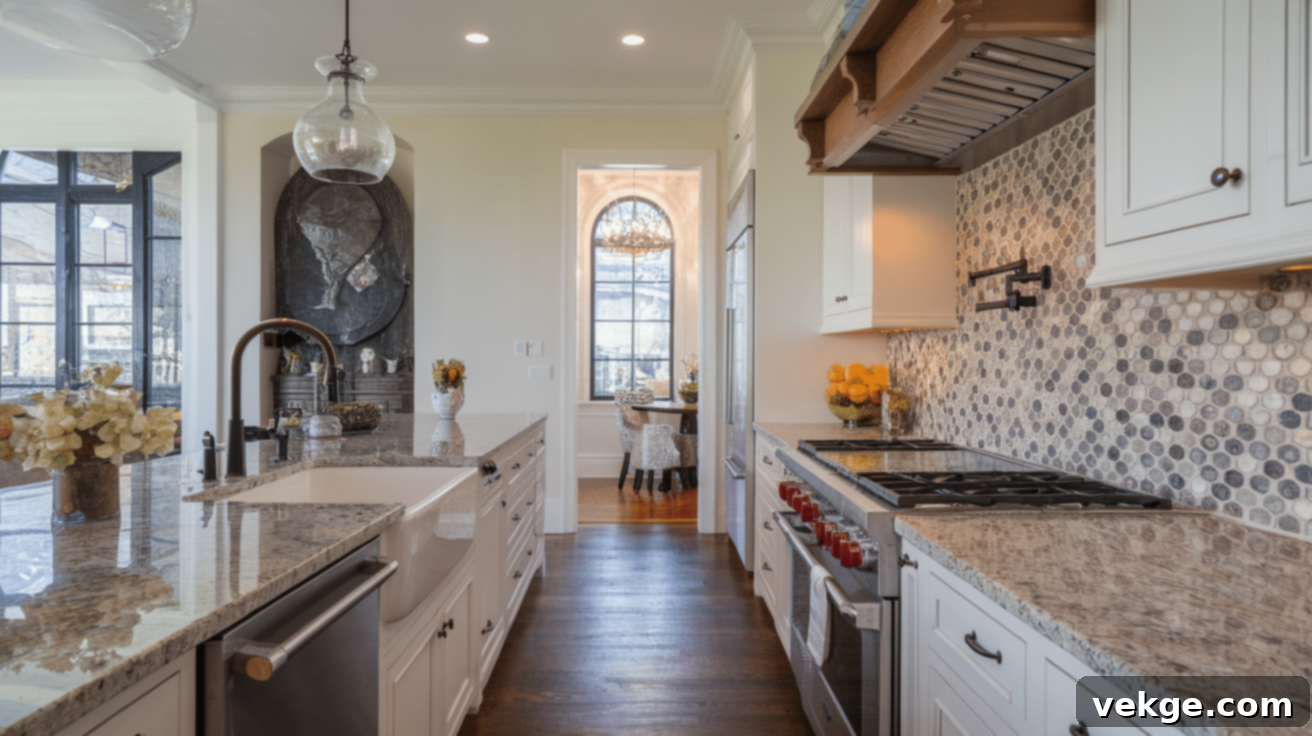
When working with a granite countertop that features a relatively consistent, less busy pattern, pairing it with a classic mosaic tile backsplash can introduce a vibrant burst of character and depth. To ensure a cohesive design, select mosaic tiles that incorporate one or more of the accent colors found within your granite. This strategy allows the backsplash to become a stunning focal point, drawing the eye and adding an artistic dimension to your kitchen. It’s a wonderful way to personalize your space and highlight unique design elements.
11. Beige Quartz Countertop with Beige Subway Tile
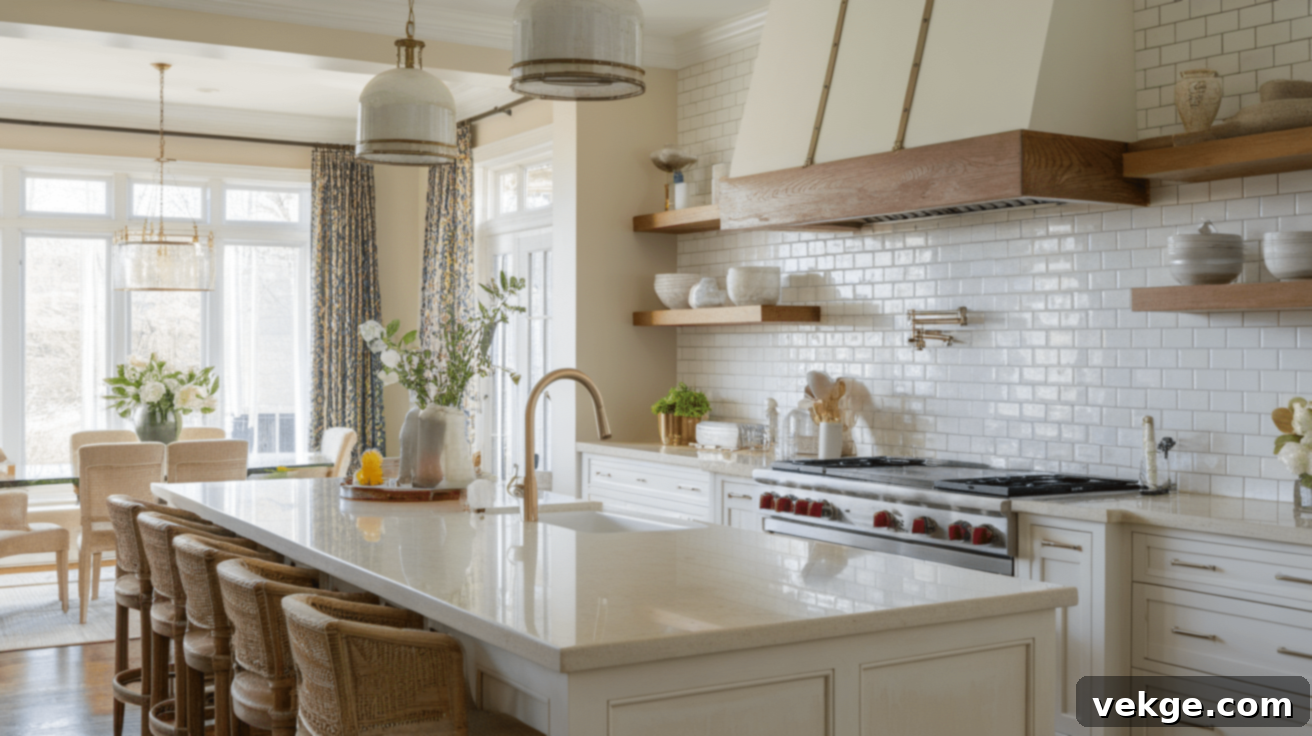
Cultivate a soft, inviting, and inherently welcoming kitchen environment with the gentle combination of a beige quartz countertop and a matching beige subway tile backsplash. This neutral pairing serves as a beautiful and understated backdrop, allowing your cabinet colors, artwork, and kitchen accessories to take center stage without competition. Beige tones are incredibly adaptable, seamlessly integrating into a myriad of design styles, from the most contemporary to traditional, ensuring a timeless appeal that remains elegant and comfortable for years to come.
12. Concrete Countertop with White Subway Tile Backsplash
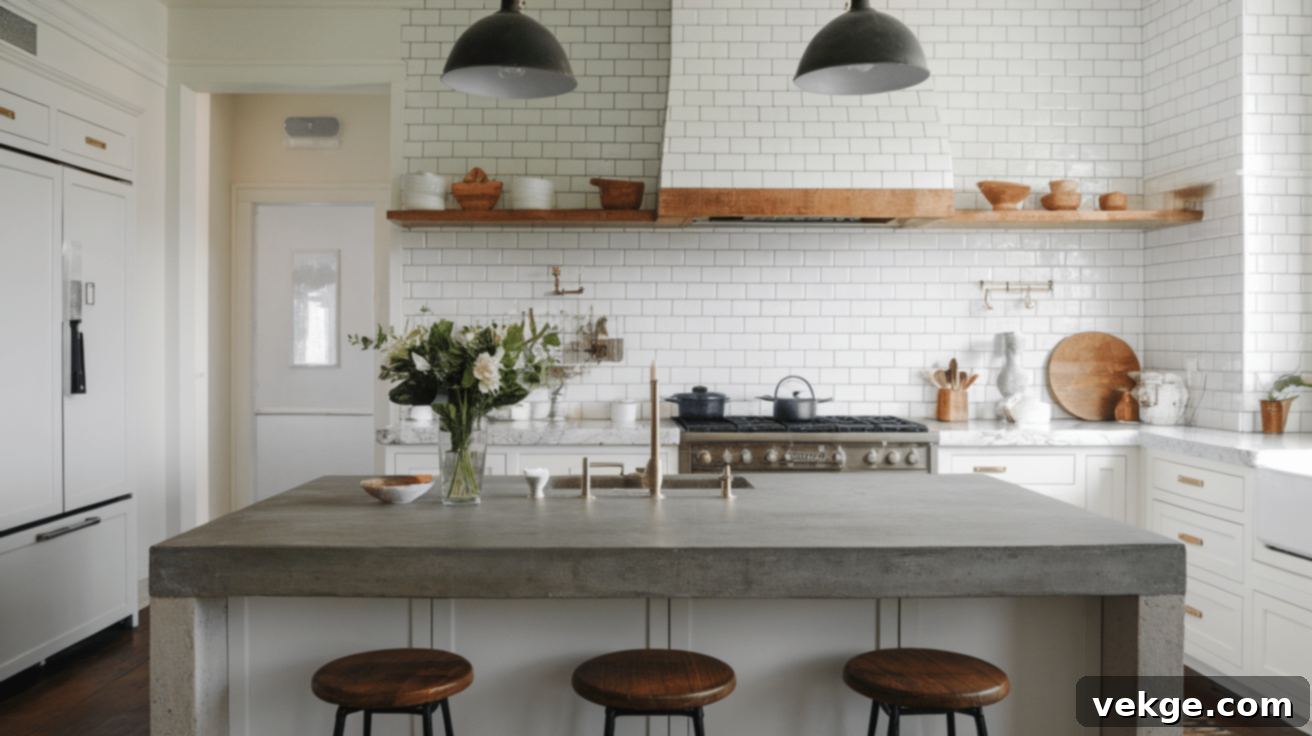
The raw, industrial texture and distinctive character of a concrete countertop achieve a refined polish when juxtaposed with crisp white subway tiles. This combination masterfully balances rugged, urban elements with classic, clean lines, resulting in a kitchen that feels both cutting-edge and enduring. The smooth, bright white tiles serve to highlight the unique, often subtle imperfections of the concrete surface, making its industrial charm feel more intentional and sophisticated. It’s an ideal choice for modern lofts or homes seeking an urban-chic aesthetic.
13. Black Soapstone Countertop with White Marble Backsplash

Experience a stunning visual contrast by pairing the deep, velvety matte finish of a black soapstone countertop with a bright, luminous white marble backsplash. This bold and sophisticated duo feels both refreshingly modern and inherently classic, allowing the distinct beauty of each material to be fully appreciated. The interplay of different finishes—matte versus polished—adds significant depth and luxurious texture to the kitchen space, creating an engaging and dynamic environment that truly stands out. It’s a statement of daring elegance.
14. Wood-Look Countertop with Matching Wood Tile Backsplash
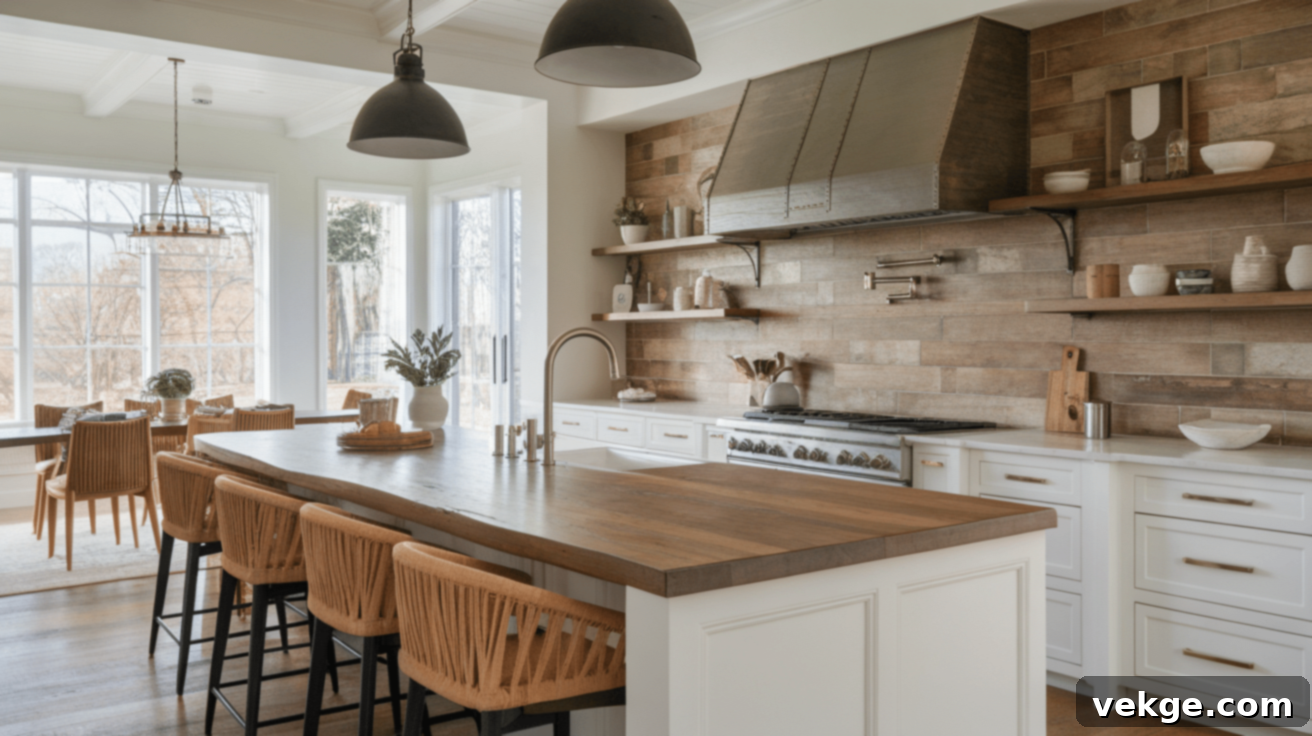
Embrace a wonderfully cozy and harmonized kitchen aesthetic by pairing warm wood-look countertops with a matching wood-patterned tile backsplash. This combination effectively brings the comforting elements of natural wood indoors while offering superior durability and easier maintenance compared to real wood, especially for the backsplash. The consistent “wood” theme throughout the space creates a unified and inviting atmosphere, making smaller kitchens feel larger and more cohesive. It’s particularly well-suited for country, farmhouse, or rustic-inspired homes seeking a touch of natural charm.
15. Limestone Countertop with Matching Limestone Backsplash
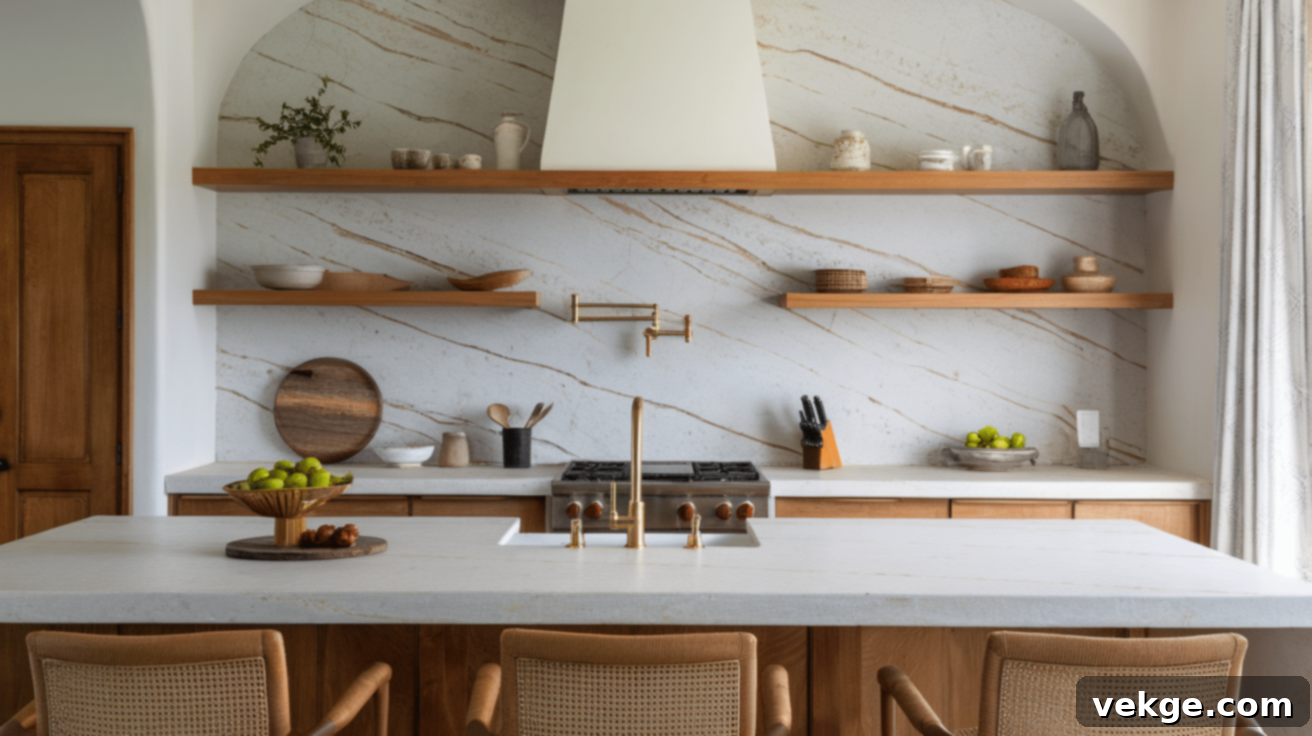
For a kitchen that embodies a serene, organic sensibility, utilizing the same limestone for both the countertop and backsplash creates a flawlessly smooth and natural look. The inherent earthy tones and subtle variations in limestone’s pattern introduce visual interest without overwhelming the space, making it a superb choice for kitchens aiming for a calm and unpretentious elegance. This pairing is especially effective in kitchens with minimalist or nature-inspired color palettes and straightforward cabinet designs, allowing the natural stone to be the star without excessive competition.
16. Bold Patterned Granite Countertop with Solid Color Backsplash
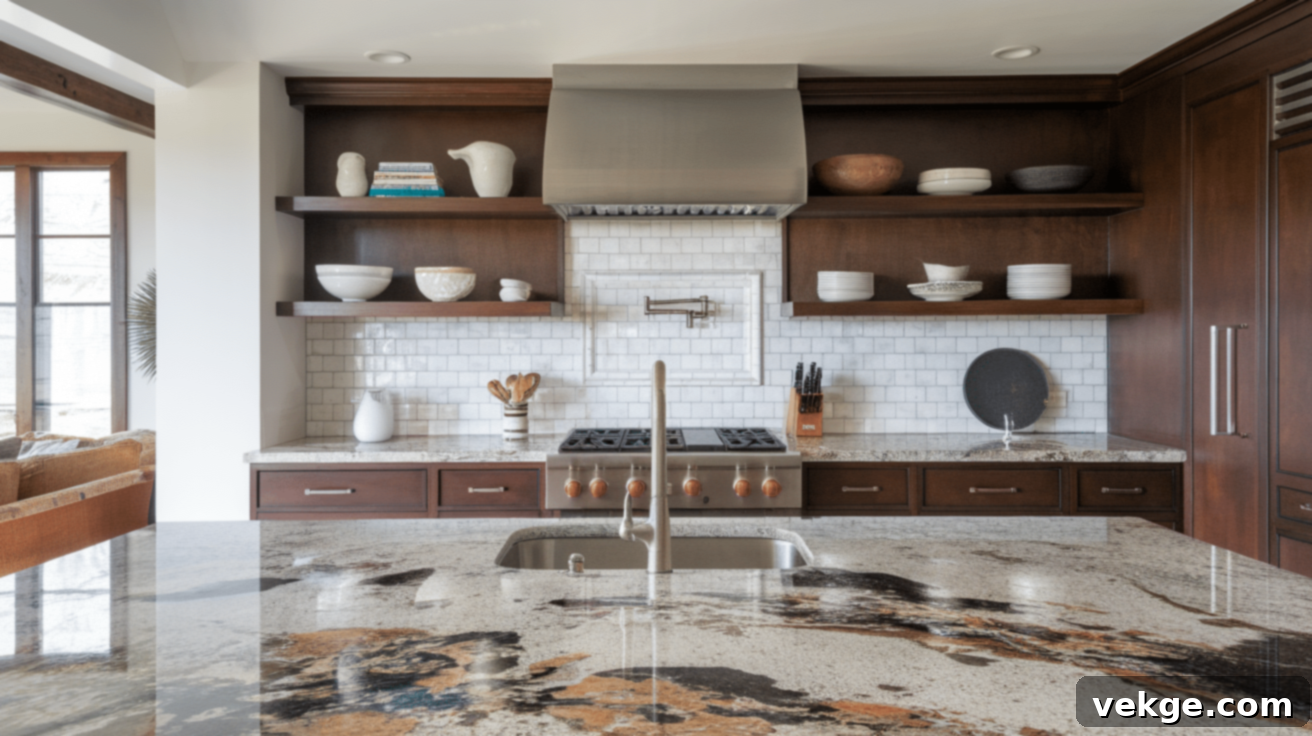
When your granite countertop boasts a truly striking and intricate pattern, the wisest design choice is often to pair it with a simple, solid-colored backsplash. This intelligent combination ensures that the countertop remains the undisputed star of your kitchen, preventing the space from appearing too busy or visually chaotic. To achieve perfect harmony, select a backsplash color that gently echoes one of the subtle, less dominant hues present in your granite. This allows the natural beauty of the stone to truly captivate while maintaining overall balance and sophistication.
17. Pink Marble Countertop with White Tile Backsplash
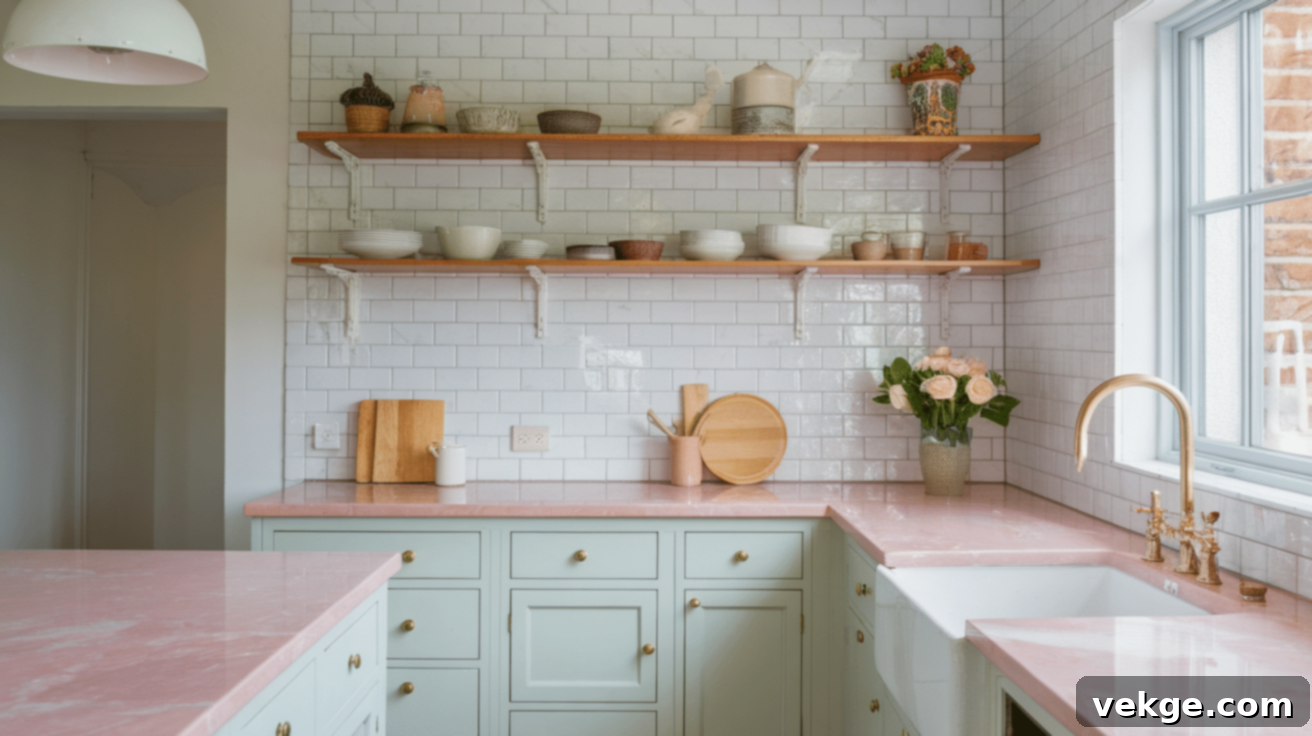
Introduce a unique touch of delicate elegance to your kitchen with the soft, inviting tones of pink marble countertops, beautifully complemented by a clean white tile backsplash. This gentle yet distinctive combination works wonders in kitchens featuring white or light gray cabinets, creating a fresh and subtly luxurious ambiance. The bright white backsplash not only helps to illuminate the space but also allows the nuanced pink veining in the marble to emerge as a delicate yet captivating focal point, adding a surprising layer of warmth and charm.
18. Blue Marble Countertop with Light Gray Backsplash
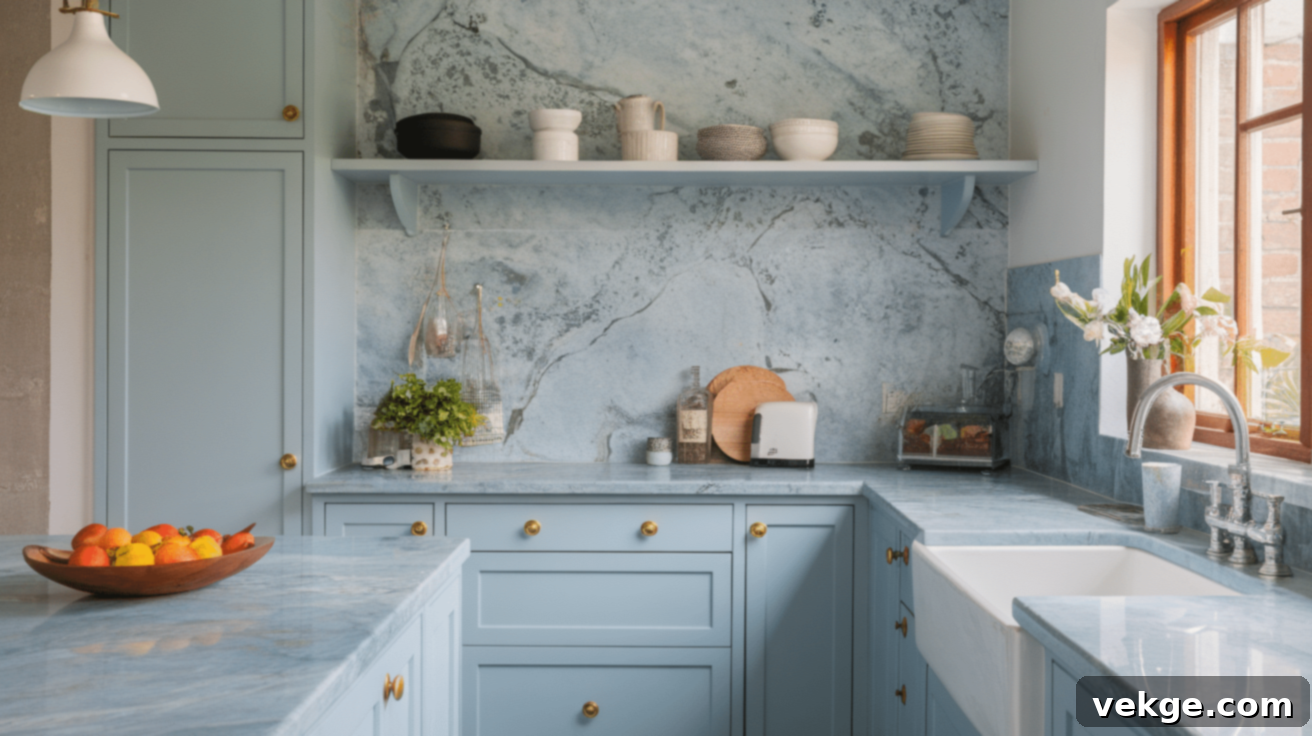
For a truly distinctive kitchen, blue marble countertops introduce a rare and captivating color element. When paired with light gray backsplash tiles, the marble’s unique hues are allowed to shine against a subtle, non-competitive backdrop. This pairing embodies a harmonious blend of classic sophistication and modern flair, making it adaptable to a diverse range of kitchen styles. The cool, calming tones create a wonderfully tranquil cooking environment, particularly delightful in kitchens that receive ample morning sunlight, enhancing the serene quality of the blue.
19. Green Quartz Countertop with White Subway Tile

Embrace a nature-inspired aesthetic with the vibrant, yet sophisticated, presence of green quartz countertops, perfectly paired with the timeless simplicity of white subway tile. This combination strikes an ideal balance between bold color and classic restraint, crafting a kitchen that feels both contemporary and enduringly stylish. The clean white tile brilliantly reflects light, brightening the space and making the rich green tones within the quartz appear even more saturated and vivid. It’s an excellent choice for a fresh, lively, and inviting kitchen.
20. Dark Soapstone Countertop with Glossy White Tile Backsplash
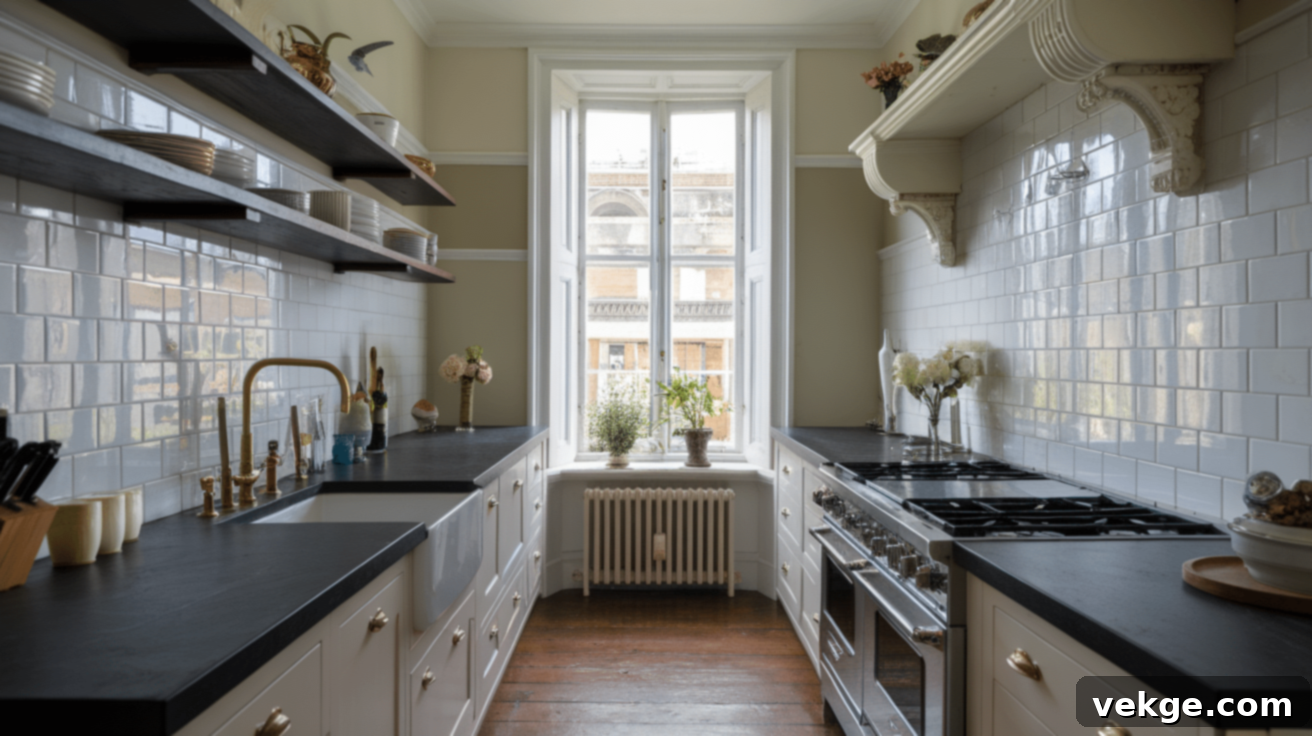
The deep, profound matte finish of soapstone countertops creates a magnificent contrast against the reflective sheen of glossy white tiles. This bold and dynamic pairing works beautifully across both modern and traditional kitchen designs, injecting a sense of drama and sophistication. The light-colored backsplash skillfully balances the inherent darkness of the countertop, preventing the kitchen from feeling too heavy while simultaneously crafting a dramatic, eye-catching effect. It’s a sophisticated play on textures and tones that elevates the entire space.
21. White Quartz Countertop with White Subway Tile Backsplash
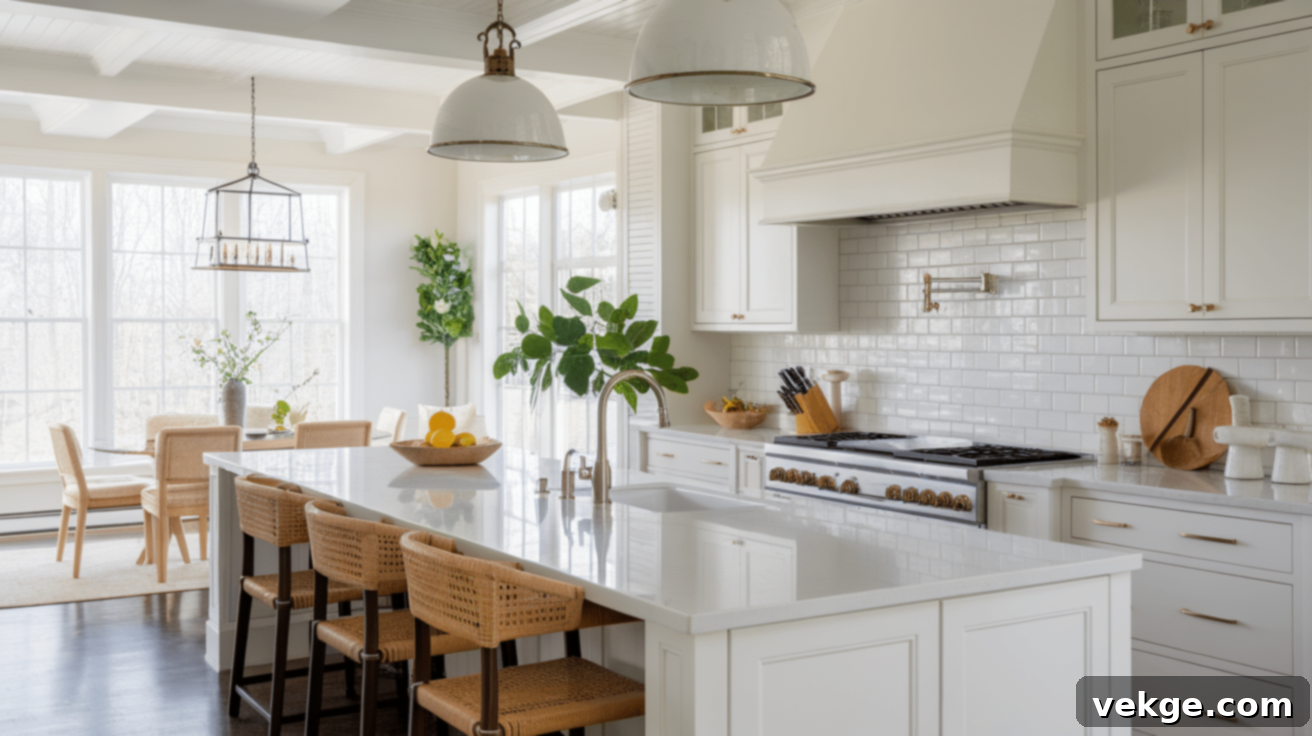
For a perpetually bright, immaculate, and utterly versatile kitchen aesthetic, the pairing of a white quartz countertop with a white subway tile backsplash is an unbeatable choice. The classic subway tile pattern introduces a subtle textural element, maintaining visual interest while adhering to a pristine white theme. Beyond its undeniable beauty, this combination is incredibly practical: both materials are renowned for their ease of cleaning and maintenance, making them ideal for the demands of a busy kitchen. White quartz resists staining, and the tile backsplash offers robust protection against cooking splashes, ensuring longevity and lasting appeal.
22. Marble Countertop with Glass Tile Backsplash
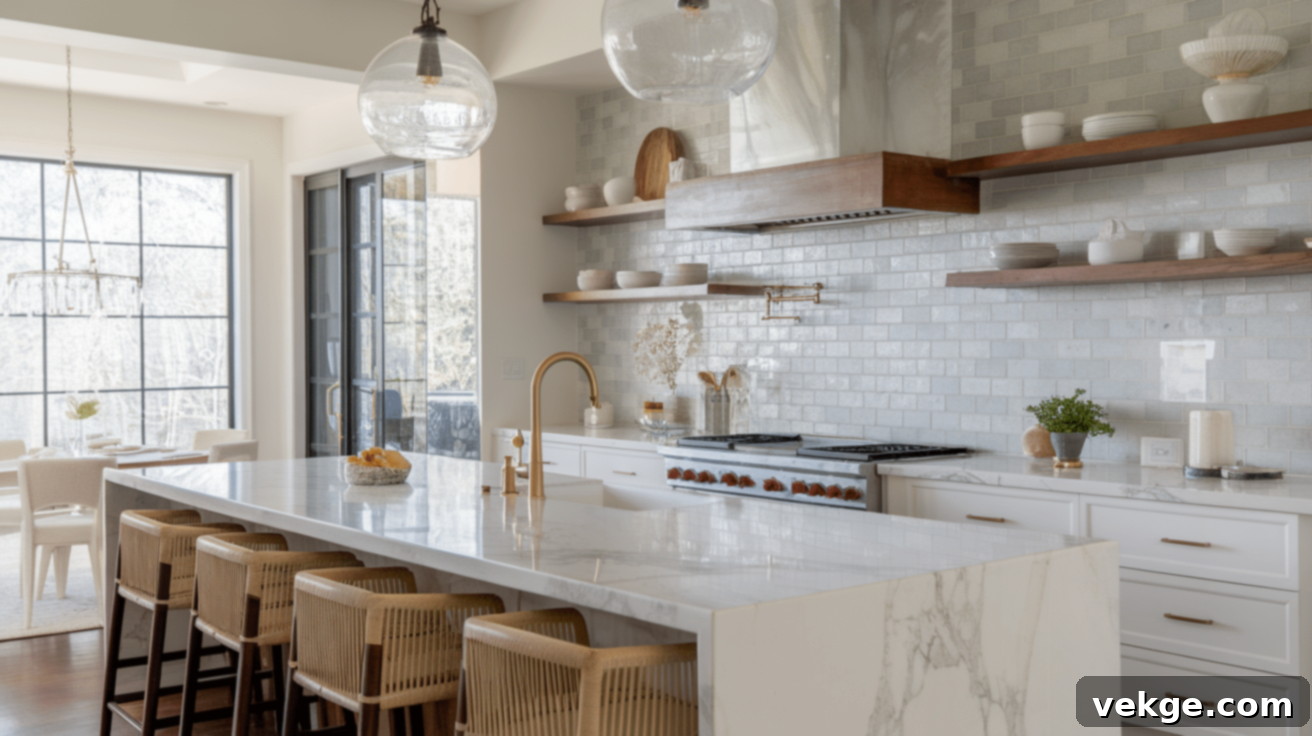
Natural marble countertops, with their unique and captivating veining patterns, achieve a stunning contemporary flair when paired with sleek glass tiles. The clear or subtly tinted glass introduces a modern, ethereal touch to the kitchen, allowing the inherent beauty and intricate details of the marble to remain the undisputed main focus. This combination is particularly effective in kitchens that aim for a sophisticated blend of classic elegance and current trends, merging the timeless allure of marble with the light-reflecting, expansive qualities of glass. It’s a pairing that truly sparkles.
23. Granite Countertop with Bold Patterned Tile Backsplash
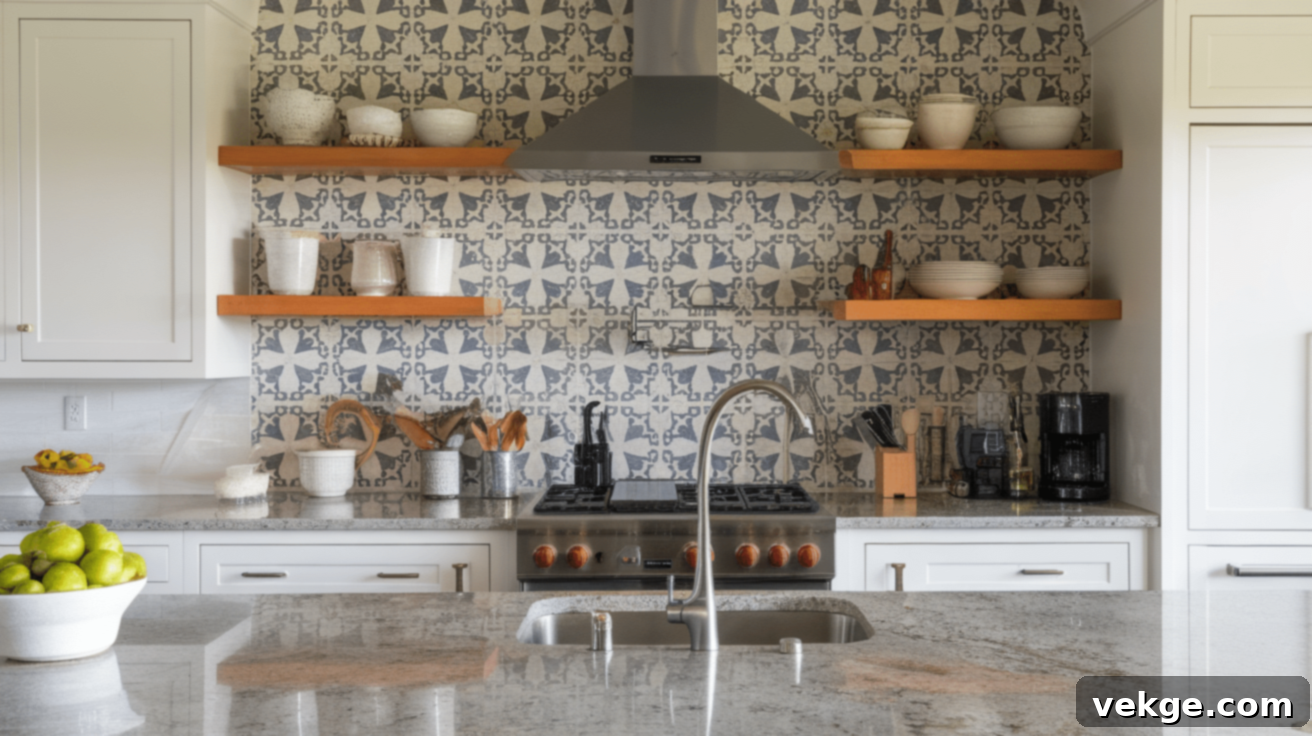
When you wish to make a distinctive statement with your backsplash, a solid or subtly patterned granite countertop provides the perfect grounded base. The stable, often speckled surface of granite offers enduring beauty without competing for attention against a lively, boldly patterned tile backsplash. This intelligent pairing allows you to inject significant personality and artistic flair into your kitchen through the backsplash, while the practical and durable granite keeps the overall design feeling balanced and functional. It’s an opportunity for creative expression with a solid foundation.
24. Wood Countertop with Black Tile Backsplash
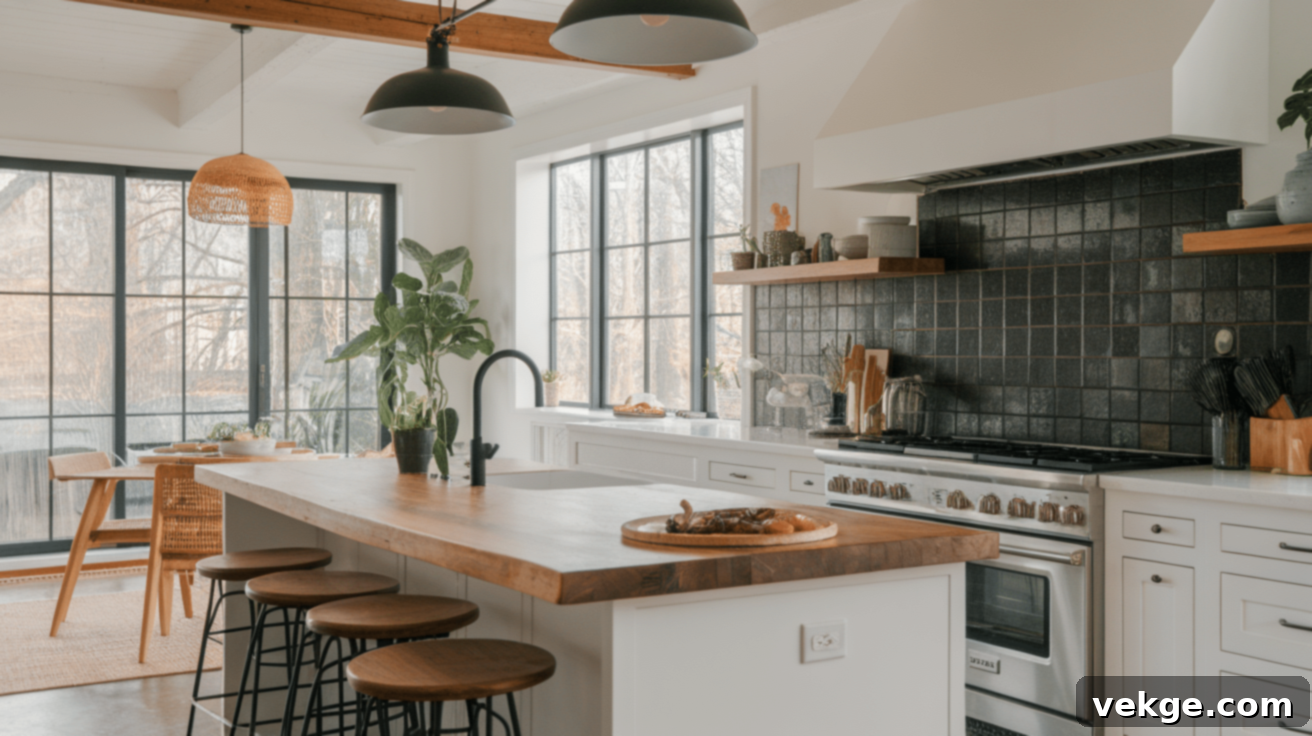
The inherent warmth and organic texture of wood countertops create a striking and sophisticated contrast against the sleek, modern aesthetic of black tiles. This pairing masterfully brings together the cozy charm of natural elements with clean, contemporary lines, resulting in a kitchen that is both inviting and stylish. The black backsplash beautifully highlights the unique grain patterns and rich colors of the wood, while providing a highly practical, easy-to-clean surface in areas prone to splashes, protecting the wood from potential damage and enhancing its longevity.
25. Calacatta Quartz Countertop with Calacatta Tile Backsplash
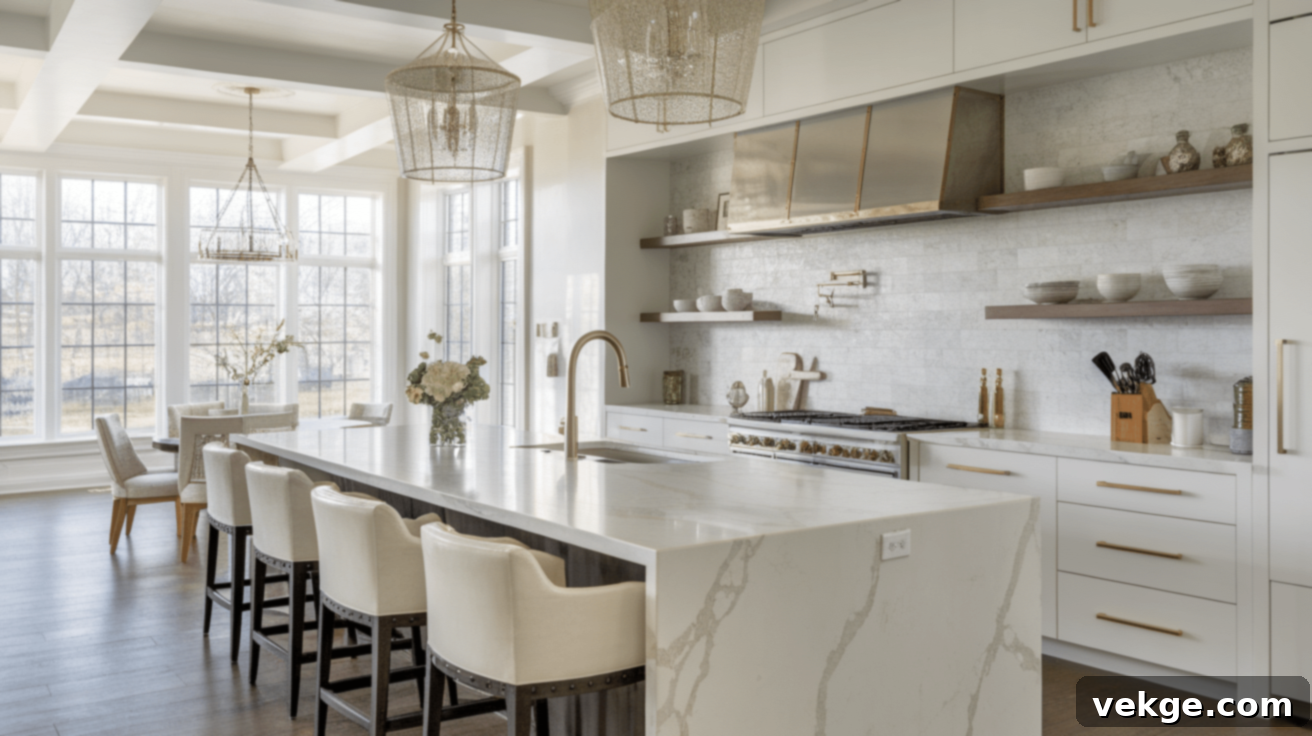
Achieve an exquisitely luxurious and expansive feel by using Calacatta-style quartz for both your countertop and backsplash. This seamless application, characterized by its pristine white background and dramatic gray veining, creates a smooth, continuous surface that visually enlarges the space. The sophisticated veining provides ample interest without cluttering the aesthetic, making it an ideal choice for smaller kitchens where too many different materials might create a cramped or busy sensation. It’s a statement of refined elegance and intelligent spatial design.
26. Beige Granite Countertop with Soft Beige Tile Backsplash
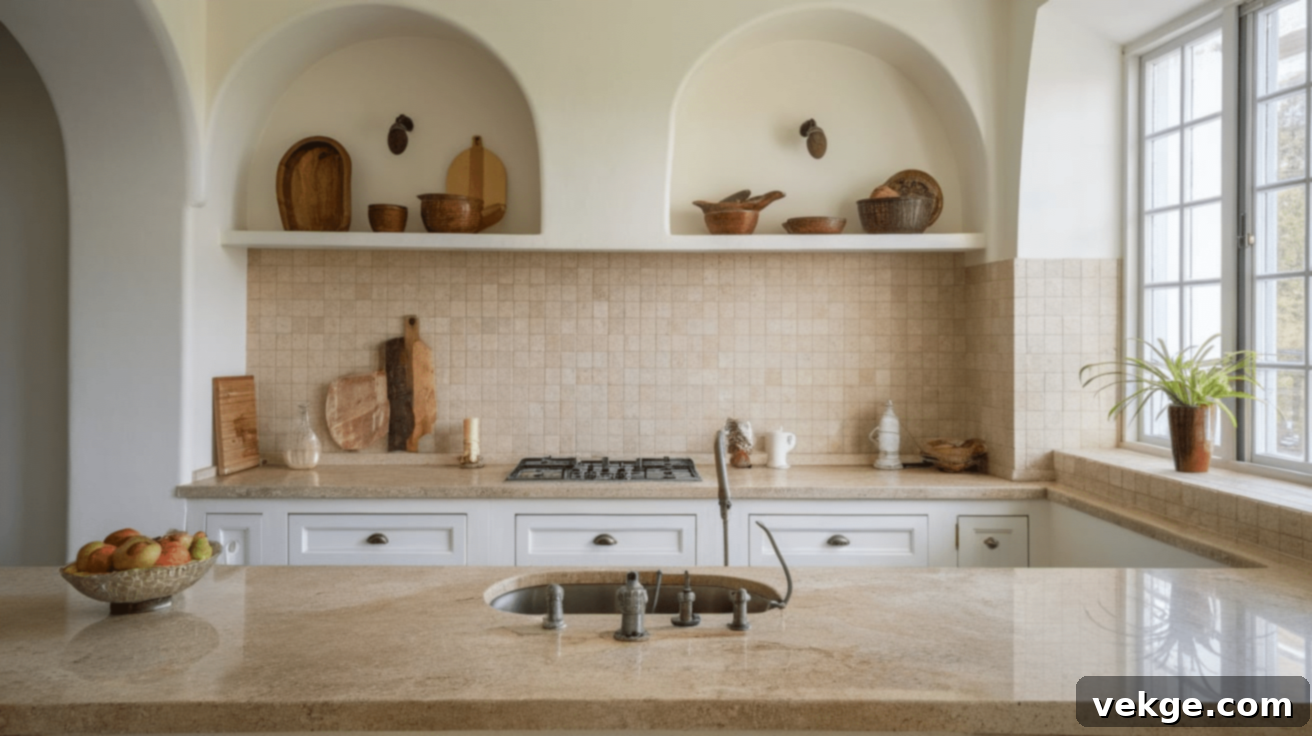
This gentle and understated color combination fosters a profoundly warm and welcoming atmosphere in your kitchen. The natural stone countertop, with its subtle speckles and organic movement, finds a perfect partner in simple beige tiles that elegantly complement without vying for attention. This neutral pairing establishes an excellent foundational backdrop, allowing more colorful kitchen accessories, unique decor, and even cabinet choices to truly stand out. It also offers the significant advantage of allowing for easy decor updates over time without the need to replace major, costly elements.
27. Dark Granite Countertop with Metallic Tile Backsplash

For a touch of industrial chic and modern glamour, pair a deep-toned granite countertop with a shimmering metallic tile backsplash. The dark granite provides a solid, grounding presence, while the shiny metallic tiles introduce dynamic light reflection and movement to the kitchen. This combination is particularly striking in spaces with well-designed lighting, as the metallic elements will effectively bounce light, brightening and expanding the area. The contrast between the matte, natural stone and the gleaming, engineered tiles creates captivating visual interest without relying on bright colors, perfect for a sophisticated, contemporary aesthetic.
Essential Considerations for Matching Countertops and Backsplashes
Beyond aesthetics, several critical factors must guide your decision-making process when selecting the perfect countertop and backsplash combination for your kitchen or bathroom. Thoughtful consideration of these elements ensures both beauty and long-term satisfaction.
Material Compatibility: A Foundation for Design
The success of your kitchen design often starts with understanding how different materials interact, both visually and practically. Not all materials are destined to be paired together. For instance, engineered quartz countertops are renowned for their versatility and often find their ideal match in a seamless full-height quartz backsplash, creating a striking, unbroken aesthetic. Natural stone granite countertops, with their unique patterns, can either be extended as a granite backsplash or beautifully complemented by ceramic, porcelain, or natural stone tiles that cleverly echo the colors and tones within the granite. Design experts consistently advise homeowners to first select their countertop material—often the most significant investment—and then meticulously choose a backsplash that truly enhances and complements it, rather than competing for attention. Consider how the textures, sheen, and inherent properties of each material will blend together.
Color Coordination: Crafting a Harmonious Palette
Achieving the right color balance is paramount for a cohesive and visually pleasing kitchen. If your chosen countertop material, especially granite or marble, features a complex array of colors and patterns, a powerful strategy is to pinpoint one or two dominant or accent colors within it. These selected hues can then be cleverly highlighted or subtly referenced in your backsplash choice, creating a subtle yet impactful visual link. For countertops that are particularly busy or vibrant, a simpler, more understated backsplash design often works best, allowing the countertop to remain the star without overwhelming the space. Cabinets, especially versatile white cabinets, offer immense flexibility, providing a neutral backdrop that allows for both bold contrasting combinations and serene monochromatic pairings. Always remember that the perception of color changes with light; therefore, it is strongly recommended to bring samples of both your countertop and backsplash materials home to observe them under your kitchen’s unique natural and artificial lighting conditions before making a final decision.
Practicality and Maintenance: Designing for Real Life
An aesthetically perfect combination loses its charm if it isn’t practical for your daily life. It is crucial to evaluate both countertop and backsplash materials for their ease of cleaning, durability, and required maintenance. Materials like natural marble, while stunning, are often porous and require regular sealing and careful cleaning to prevent staining and etching, making them higher maintenance. Engineered quartz, on the other hand, is non-porous and remarkably easy to clean and maintain, resisting stains and scratches. Backsplashes with numerous grout lines, such as intricate mosaics or small ceramic tiles, can be more challenging to keep pristine, particularly in high-splash zones behind the cooktop or sink. Conversely, a slab backsplash minimizes grout lines, offering a sleek and easy-to-wipe surface. When considering a full-height slab backsplash made from the same material as your countertop, ensure the material is appropriate for vertical applications and that the installation will accommodate wall irregularities smoothly. Your lifestyle, cooking habits, and willingness for upkeep should heavily influence your material choices.
Lighting Impact: Illuminating Your Choices
The way light interacts with your countertop and backsplash materials can dramatically alter their appearance. Natural light, artificial overhead lighting, and under-cabinet lights all cast different hues and intensities. A glossy backsplash will reflect light, making a small kitchen feel larger and brighter, while a matte finish absorbs light, creating a warmer, more subdued atmosphere. Dark materials can make a room feel cozier but might require more artificial light. Always test samples in your actual kitchen throughout the day to see how they look under various lighting conditions, ensuring no surprises after installation.
Budget Planning: Balancing Dreams and Reality
Your budget is a significant determinant in material selection. Natural stones like marble and high-end granite, or full-slab backsplashes, are typically more expensive than ceramic or porcelain tiles. Engineered materials like quartz can vary widely in price depending on the pattern and brand. By mixing and matching, you can often achieve a luxurious look without the premium price tag for every surface. For example, splurging on a high-quality countertop and opting for a more affordable yet complementary subway tile backsplash can yield stunning results while keeping costs manageable. Be sure to factor in installation costs, which can vary significantly based on material complexity and labor.
Overall Kitchen Style: Unifying Your Vision
Finally, your countertop and backsplash choices should align with the overall design aesthetic you envision for your kitchen. Are you aiming for a sleek modern space, a cozy farmhouse vibe, an industrial edge, or a timeless traditional look? Each material and pairing suggestion in this guide lends itself to different styles. For instance, a continuous quartz slab backsplash screams modern, while a wooden countertop with subway tile fits perfectly into a rustic or farmhouse setting. Ensure your selections contribute to, rather than detract from, your desired cohesive kitchen theme.
Common Mistakes to Avoid in Countertop and Backsplash Pairing
Even with the best intentions and a clear vision, it’s surprisingly easy to make design missteps when coordinating these two pivotal kitchen elements. Being aware of common pitfalls can safeguard your project, helping you create a space that you will truly cherish for many years to come, free from regrets. Many homeowners encounter similar traps during their selection process, which can negatively impact both the visual appeal and the practical functionality of their kitchen. Here are some critical mistakes to watch out for, along with advice on how to steer clear of them:
- Using Too Many Competing Patterns: This is perhaps the most common mistake. When both your countertop and backsplash feature bold, intricate patterns, they often clash, creating visual chaos and making the kitchen feel busy and overwhelming.
How to Avoid: Decide which element you want to be the star. If your granite or marble countertop has dramatic veining, opt for a simple, solid-colored backsplash. Conversely, if you love a statement backsplash, choose a more subdued, uniform countertop.
- Selecting Backsplash Materials Difficult to Clean: Certain materials or designs, especially those with excessive grout lines or porous textures, can be a nightmare to maintain in high-splash areas. Grease and food splatters can quickly accumulate, leading to discolored grout or stained surfaces.
How to Avoid: Prioritize practicality for your lifestyle. In cooking zones, choose materials that are easy to wipe down, like large format tiles, glass, or a slab backsplash with minimal grout. Seal porous materials diligently.
- Choosing Trendy Combinations That Quickly Look Dated: While it’s fun to incorporate current trends, overdoing it can lead to a kitchen that feels passé in just a few years.
How to Avoid: Balance trends with timeless elements. If you love a trendy color or pattern, use it in easily changeable elements like accessories or paint. For fixed surfaces, lean towards classic materials and neutral palettes, or integrate trends subtly.
- Not Considering How Natural and Artificial Light Affect Materials: The appearance of colors and textures can drastically change under different lighting conditions. What looks perfect in a showroom might look completely different in your kitchen.
How to Avoid: Always bring samples home. Observe them at different times of day, under natural light, and with your kitchen’s artificial lighting turned on. This ensures true color accuracy and material interaction.
- Installing a Backsplash That Stops Abruptly or Awkwardly: A backsplash that ends mid-wall without a clear architectural break can look unfinished and visually jarring.
How to Avoid: Plan the termination points carefully. Backsplashes should ideally extend to the upper cabinets, meet a natural corner, or continue around a window or door frame. Consider a full-height slab for a seamless look.
- Forgetting to Account for Countertop Edge and Backsplash Junctions: The point where the countertop meets the backsplash is a critical detail. An unprofessional transition can detract from the overall design.
How to Avoid: Discuss edge profiles and transition details with your fabricator and installer. Ensure a clean, tight, and well-sealed junction. Consider if a small caulk line or a slight overhang will look best.
- Picking Materials That Don’t Stand Up to Your Kitchen’s Daily Use: An artistic choice might look great, but if it scratches, stains, or damages easily under your typical kitchen activities, it will lead to frustration and premature wear.
How to Avoid: Be honest about your kitchen usage. If you’re a heavy cook, opt for durable, low-maintenance materials like quartz or sealed granite. If aesthetics are paramount and you’re willing to be careful, then more delicate options like unsealed marble might be suitable.
Conclusion
Finding the perfect synergy between your kitchen countertop and backsplash is an art, deeply rooted in thoughtful planning and a keen understanding of your personal style. The most successful kitchens are those that masterfully balance captivating visual appeal with the practical demands of daily life. Begin your design journey by selecting a countertop material that resonates with you, considering its aesthetic and functional attributes. From there, choose a backsplash that either exquisitely complements its partner or boldly contrasts it in a deliberate and stylish manner. Always remember to evaluate how these materials will endure the rigors of your everyday life, not just how they captivate in a showroom setting.
Whether your preference leans towards a sleek, uninterrupted look achieved with matching materials, or a more dynamic approach with carefully chosen complementary elements, the ultimate goal is to craft a kitchen that feels profoundly cohesive and uniquely personal. With the right pairing, your kitchen will not only serve as a beautiful centerpiece for your home but also remain a highly functional and inspiring space for countless years to come.
